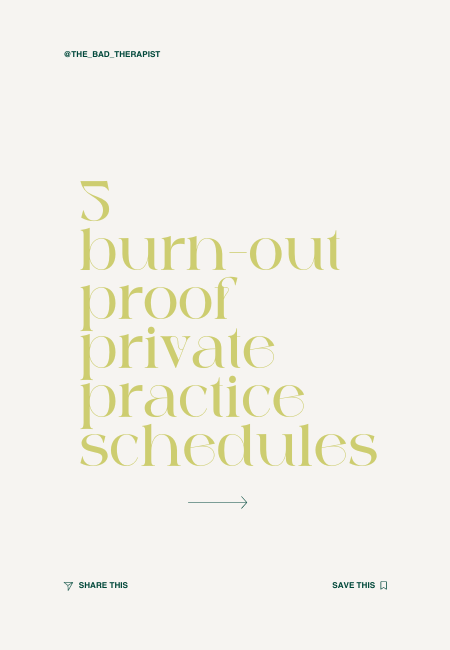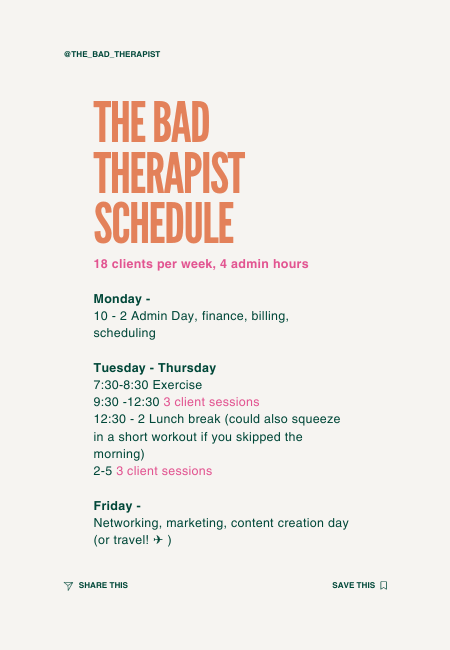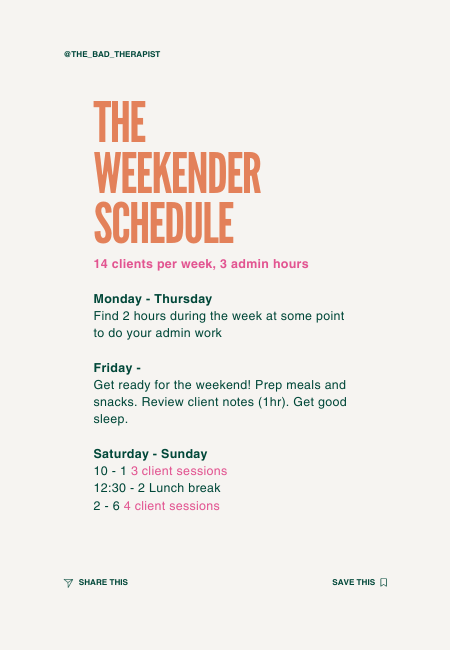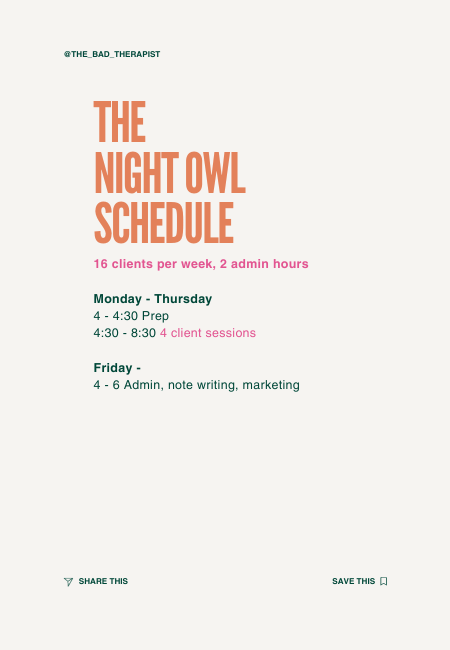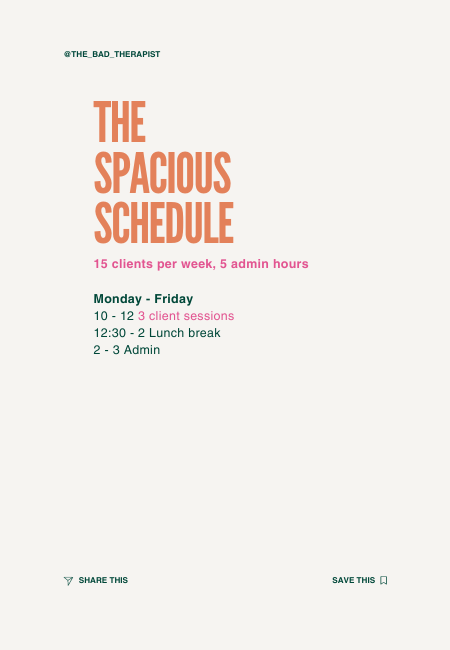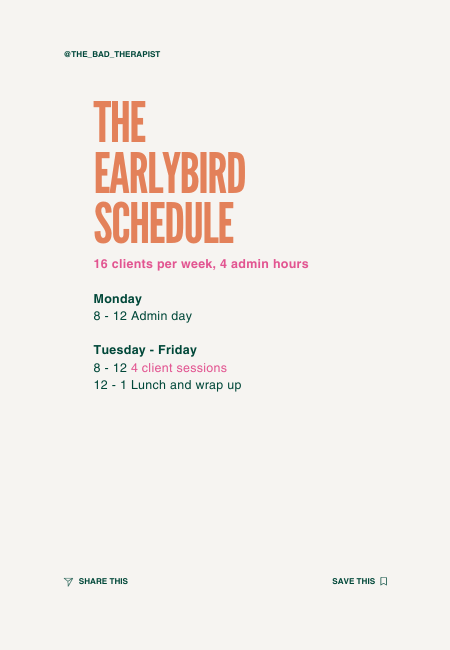How Many Clients Does a Therapist Have In 2025? | Number of Clients You Should Actually Have
The therapists I work with usually feel best seeing between 10 and 15 clients per week. This leaves time in their schedules to do all the admin associated with running their practice like write notes, respond to client emails and new client inquiries, complete online marketing tasks, network with other therapists, get continued education, and enjoy their personal lives.
If we haven’t met yet, hello! 👋🏻 I’m Felicia, the Bad Therapist©. I’m a business coach who helps therapists make more money and impact in their practices without sacrificing their values and pleasure.
When you’re building your practice, it’s normal to wonder how many clients a therapist has on average. However, the answer is not as straightforward as you might think (or hope). In this post, I’ll share my top tips to help you decide on the caseload size that’s right for you.
Being a therapist is a demanding job. We sit and talk to people all day delving into the most intimate details of their lives. We literally lend our nervous systems to co-regulate theirs and help them face trauma head-on. This kind of work requires some serious energy.
You may be coming from an agency background where you were expected to do this kind of work for 30 or more hours a week with no regard for your own mental health. But is that really sustainable? Definitely not. Mental health therapists burn out at an alarming rate, many of them before even becoming licensed!
Is it possible to actually build a successful, wealth-generating practice working less time and seeing fewer clients? Absolutely! And more than that, your career, your clients, and your well-being depend on it.
Why you should limit your caseload
-
A 2018 study of community mental health therapists in Los Angeles found that larger caseloads amongst their participants were predictive of emotional exhaustion, a precursor to burnout. The American Psychological Association also identifies these factors that increase vulnerability to occupational stress:
Overworking
Isolation
Poor boundaries with clients
Over-involvement with clients
Unbalanced client load (e.g., working exclusively with a high trauma client load)
Beyond personal consequences like depression, divorce, and stress-related illness, there can also be negative ripple effects. Our clients might experience malpractice or loss of faith in therapy. Plus, the whole field is impacted by therapist attrition, lawsuits, and loss of credibility.
-
The number of clients a therapist sees matters. It might be tempting to let your past experiences at agencies or group practices, your supervisor's feelings, or what other therapists are doing influence your caseload.
In reality, though, your well-being is more important than any of these factors. Therapists shouldn't see more clients just because they can. Instead, we have to actively confront the "good therapist conditioning" we've learned and choose a better way for ourselves.
If this is the first you're hearing about good therapist conditioning, welcome :) This is the foundation of my work as a business coach for therapists, and something I hold close to my own heart. Basically, this concept refers to the culture the mental health system has created. Overworking and lack of self-care have become the norm among therapists. But it doesn't have to be this way. By putting your well-being first, you challenge all of that.
-
Prioritizing your own self-care should be reason enough to limit your client load. But if I haven’t convinced you of that, do it for your clients. It's literally in the best interest of your therapy clients that you limit the number of sessions you provide each week. Seeing fewer clients will mean that each person in your schedule gets your very best.
Worried about saying "no" to "people who need it?" Remember, there are other fantastic therapists out there for whom those clients could be an even better fit. You don't have to (and simply can't) be everything to everyone.
Here are a few signs that your caseload is starting to impact your clients.
You feel tired all the time and it's hard to focus during your last couple sessions of the day
You head into the week hoping a couple clients will cancel.
You know it would be helpful to challenge your client but you're afraid of their reaction and just don't have it it in you deal with it today.
You find yourself thinking 'must be nice!' when a client tells you they're going on a vacation or they're saving for a second home.
You don't have any energy left to answer new client inquiries, respond to emails, or return calls.
You're months behind on your case notes.
-
If you overwork, you burn out and leave the field. You may have already been on the brink of leaving. You almost certainly know therapists who have burnt out. You've invested literally thousands of hours and tens of thousands of dollars to get to this point in your career. The best possible scenario is that you not only have a private practice you love but that you earn enough money to make back your initial investment many times over.
In order to do that, we have to make sure you don't burn out. (Check out my Magic Sheets income calculator tool and this blog post for even more guidance on how to design your private practice to meet your financial goals.)
I’ve made it my personal mission to rid our industry of the habit of burning out clinicians. And this happens one clinician at a time refusing to be complicit in an industry that exploits mental health therapists.
-
While you may work full-time in your practice, providing therapy for 40 hours a week is simply not sustainable. As a private practice owner, meeting with clients is only one of your many duties. Sure, you can certainly hire out many of the tasks associated with running your business. But you will still need to manage other responsibilities like finances, marketing, administration, etc. If you are just starting out in private practice, carve out at least 3 hours per week for non-client services work in your business.
Questions to ask yourself when deciding how many clients to have
How many patients does a therapist have? The data doesn’t exist to tell us how many clients (on average) private practice mental health therapists see.
But I can guarantee you that whatever the data would say, it’s too many clients.
When starting your own practice, it’s easy to default to the idea of a 40-hour work week, seeing the number of clients you saw at the group practice you just left, or whatever the bedraggled "good" therapist next door is saying.
I am asking you right now to let go of what you think most therapists do. Instead, start thinking about what you want and need. This absolutely has to be your starting point. Without it, you are on the way to burnout and resentment. Your magic number is out there, but you won’t find it looking at other therapists’ caseloads. It’s going to be unique to you. And I’m going to help you find it.
-
Grab a blank piece of paper and a pencil right now. Start witting the different things you want or need to do each week and how much time you'd like to spend on each of those things per week.
I first did this exercise as an associate therapist. I decided if I ever wanted my life to change in a big way, I needed to get honest with myself about what I really wanted. It turned out I wanted to have time to meet with clients, network in person with colleagues, have a writing practice in the morning, exercise, go on meditation retreats, and go dancing weekly.
I wrote out my ideal life and the time I wanted to devote to each thing. It was very far away from the life I was living at the time. There were some elements of that life that I wasn't willing or able to pursue at that time. But knowing what I wanted was the first step to creating it.
What about you? What does your best life look like? Feel free to create multiple versions. Go ahead and describe your ideal life but then take it up a notch by writing your "too good to be true" life, your mind-blowingly "how is this even possible" life. Remember that your desires aren't enemies. They're gifts.
If this idea makes you feel squirmy or you just want support on getting more intimate with your desires, check out Episode 3 of The Bad Therapist Show.
-
Sometimes, we think about our work as therapists as how we "give back" to the world. We can even "give back" so much that our other relationships suffer. We simply don't have the energy or attention left to be the people we want to be in our personal lives. And this sucks. Being a great family member, loving friend, or invested community member are all totally legitimate ways to give back.
Consider who you want to be in the larger context of your life. It's okay to drop your ideal caseload number by a few clients if that means you get to be the person, and not just the therapist, you want to be.
-
If you've been ignoring your own physical, mental, or spiritual health, because you're seeing too many clients, it's time for a change. You know by now that the consequences are too severe to be ignored. We therapists absolutely love to talk about self-care and are the strongest advocates for other people doing it.
We are often guilty of not taking our own advice. When dreaming up your schedule and ideal caseload, make sure to leave time for the activities that bring you joy, improve your mental health, and keep you healthy physically.
-
Have you been wanting to write a book? Get more training in a particular therapeutic modality? Offer services beyond traditional therapy? There is so much you can do with your training as a therapist. Many therapists choose to expand and use their skills in other areas.
In fact, nearly all therapists who come to work with me don't just work as therapists. They are also consultants, coaches, podcast hosts, and retreat leaders. I love helping private practice therapists create businesses that are as creative as they are.
-
Do you need weekends free because you have a young child and that's the best time to be with them? Then don't work weekends. Do you have family overseas that you haven't seen in years because you would really need weeks off to go see them? We need to come up with an average number of clients that would support that.
-
If you support clients recovering from trauma, work with high-conflict couples, active suicidality, or other more distressing content, you may need to take on less clients a week than other therapists in private practice. You may also decide to balance your client load by taking on a mix of high- and low-trauma clients to ensure that you don't burn out.
-
This may seem like a silly question. After all, that question is what this whole blog is about! But I'm not asking how many clients you think you need to see or could tolerate seeing. I'm asking how many you want to see.
If you knew you could make exactly the income you needed to regardless of the size of your caseload, how many clients per week would you like to see? What would be fulfilling? What would allow you to provide the most optimal care for your clients? Let your answer be honest. Even if you don't take action on it right now, this is great information to have and it's something you can work toward.
My top tips for private practice therapists who are building their caseload
-
Like I was saying earlier, your best hope for success in private practice is to be radically honest with yourself about what you want. This means becoming a good listener to yourself and practicing nonjudgment when your big, wild desires show up. You may decide to act on some of your desires right away and save others for later.
-
Most therapists set their fees and calculate how many clients they would need to see to hit their income goal. 🤦🏻♀️ This is actually the exact opposite of how you should determine your fee! When you set your fee first you usually end up with some absurd number for your average caseload.
But don't worry, I got you. I created an exact formula for setting your private practice fee to hit your income goals and a tool that will help you do it called the Magic Sheets. This will ensure that you both avoid burnout and actually make more money in your practice.
-
Don't expect your ideal caseload to be a "set it and forget it" thing. Your life, desires, and needs are going to change and your practice will need to change with it. Check in with yourself often to ask, "What do I really want?"
You may reach a point where you permanently want to reduce your caseload because your family had a second child or, I dunno, you just want to spend more time laying on the beach. You know you're allowed to want and have that. Or you may need to temporarily reduce your caseload because you're really ready to commit to the book that your muse has been begging you to write for years. Either way, know that what works for you now likely won't stay that way. It's okay to change.
-
Having a lower average caseload will mean needing to have higher fees if you want to earn the same amount of money. This is not a problem, but it's what stops a lot of therapists from going all in on reducing their caseload to a reasonable number.
Many therapists think that if they keep their fees low, they will never have to get good at marketing or sales. However, every business needs marketing. It can even be a fun and creative aspect of your business! You will need to devote some of your energy to building your skillset in these areas. Check out my Marketing Strategy Clinic and Devotional Sales Practice to get started.
-
If you want to reduce your psychic load and the amount of time you spend on scheduling, say no to clients who want to come in every other week or monthly. My long-time supervisor said even when people didn't come to their psychotherapy session, the therapy is still happening. As much as we try to confine our work to the actual session with the client, it doesn't always happen.
The fact is, the relationship continues even in the moments that therapists and patients aren't in each other's company. Even if you have the same average number of sessions per week, the energy it takes to manage a larger client load vs a smaller one is a drain on your time and energy.
How many clients does a therapist have? The short answer: it depends.
There is no set standard for how many sessions a therapist does in any given week. I have found that my clients tend to have the highest quality of life with an average caseload of 15. That said, therapists have different energy levels and have to consider different factors like chronic health issues, family, or desire to pursue other professional goals when deciding on the best schedule for them.
Your ideal caseload is one that will allow you to provide the best care to your clients while generating the income you need to reach your financial goals. Your work schedule should leave you with ample time to take care of your own mental health, pursue other personal and professional passions, and enjoy your life.
Here's an example of what my private practice schedule looked like seeing only 15 clients 3 days per week.
Get support in building a caseload that’s right for you
Do you want help designing every aspect of your private practice from how many clients to see to what to charge and how to craft a simple, effective marketing plan?
I've helped therapists all over the country (and some overseas!) create thriving practices build around their dreams. These practices are as diverse as the therapists behind them and are tailor-made to suit their needs.
Learn more about working with me as a private business coaching client, get a community learning experience in Liberated Business, or spend a day in luxury on your own CEO Day to skyrocket your growth.
Take your private practice to the next level
Ready to get started? Schedule a time to chat with me about your practice!



